PANINI
Before we go into the details of the Ashtadhyayi; such as: its structure, Its definitions, its classification of rules etc., let’s talk about Panini the person; his period; and, his associates and so on.
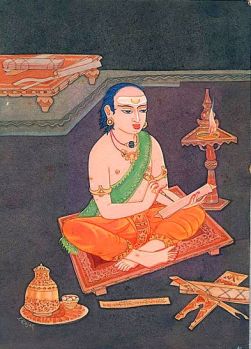
Maha Mahopadyaya Pundit Sri Harprasad Sastri (1853-1931) the famous orientalist and Sanskrit scholar of great repute, in his Magadhan Literature (a series of six lectures he delivered at the Patna University during December 1920 and April 1921) talks about Takshashila, a prominent city of the Gandhara region, a part of the ancient Indian polity included under the Greater Uttara-patha in the North-West.
[In his First lecture, the Pundit talks about Takshashila and its association with the Vedic literature. And, in the second lecture, he talks about the five great scholars who hailed from the region of Takshashila: Upavarsha, Varaha, Panini, Pingala, and Vyadi; in addition to Katyayana (Vararuchi) and Patanjali.]

Pundit Sri Harprasad Sastri says: It was at Takshashila, the city named after Taksha the son of Bharatha of Ramayana, many of the highly-admired works in classical Sanskrit had their origin. The earliest grammarian-scholars known to us also belonged to that city.
The city gained fame in the later periods, stretching up to the time of the Buddha, as the centre of trade, art, literature and politics. Takshashila was also a distinguished centre for learning, to where scholars and students from various parts of India , even as far as from Varanasi at a distance of more than 1,500 KMs, came to pursue higher studies in medicine, art , literature, grammar, philosophy etc .
[ For instance; Jivaka , the famed physician of the Buddha, in his youth , when he aspired to become a physician, left home in the Magadha region, , without informing his family, traveled all the way to Taxasila, in the distant West; to study medicine under the well-known teacher Disapamok Achariya.
There, he studied medicine diligently for seven years. Towards the end of his seven-year study, he took a practical examination that tested his medical skills and his knowledge of medical herbs. He passed the test with merit. With a little financial help and blessings of his mentor, Jivaka set out into the world in search of a carrier, fame and fortune, before he settled down in the Royal City of Rajagriha.]
**
But, the glory of Takshashila came to an abrupt end when Darius (518 BCE), the Persian monarch who destroyed the dynasty founded by Cyrus, overpowered the North-West region of India; and, annexed it into the Achaemenid Empire.
The long periods of lawlessness, anarchy and chaos totally destroyed the cultural, academic and commercial life of Taxila. And, by about the time of the Buddha, Taxila was losing its high position as a centre of learning. And, that compelled its eminent scholars like Panini the Great Grammarian, and scholars like Varsha, Upavarsha, Pingala and Vyadi to leave Taxila to seek their fortune and patronage, elsewhere. They were, perhaps, among the early wave of migrant intellectuals to move out of the Northwest towards East.
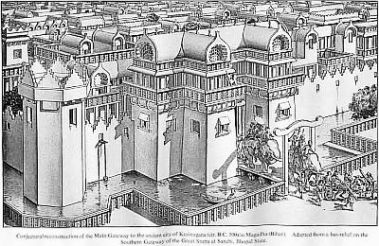
By then, Pataliputra, situated amidst the fertile plains on the banks of the river Sona, at its confluence with the Ganga, was fast rising into fame as the capital of the most powerful kingdom in the East. It was the First Imperial Capital of ancient India. By the time of the Greek ambassador Megasthenes (322 to 301 BCE.), the city had grown in to a vast sprawling metropolis, spread over an area of 80 stadia (little more than 9 miles long) and 15 stadia (about 1,3 miles), adorned with magnificent mansions and palaces, studded with beautiful sculptures. “The greatest city “, he declared, ” had 570 towers and 64 gates and was surrounded by a ditch , six hundred feet in breadth and thirty cubits in depth”.
The scholars drifting from Taxila, all reached the intellectual capital of India, the Great city of Pataliputra (Maha-nagareshu); and, there they were honored by the King in his assemblies ‘in a manner befitting their learning and their position’. And, thus began the literature of Magadha.
That also marked the birth of a new tradition.
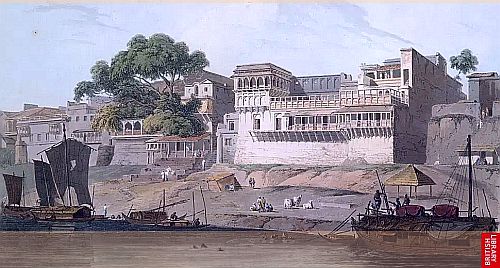
Source: British Museum
On to Pataliputra
Rajasekhara (10th century) a distinguished poet, dramatist, and scholar who wrote extensively on poetics – Alamkara shastra (the literary or philosophical study of the basic principles, forms, and techniques of Sanskrit poetry; treatise on the nature or principles of poetry); and who adorned the court of King Mahipala (913-944 AD) of the Gurjara-Prathihara dynasty, refers to a tradition (sruyate) that was followed by the Kings of Pataliputra (Kavya Mimamsa – chapter 10).
In the last passage of the Chapter Ten
‘Kavi charya, Raja charya ca ‘:Maha-nagareshu ca Kavya-shashtra pariksharthai brahma-sabah kareyet / tatra parikshe uttirnanam brahma-ratha-yanam pattabandascha // –
Rajasekhara speaks about the tradition that prevailed in the Royal Court of Magadha, just as in the manner of the Royal courts of other great City-states (Janapada) like Varanasi.
According to that tradition, the King , at the Great City of Pataliputra, occasionally , used to call for assemblies where men of learning; poets ; scholars ; founders and exponents of various systems; and , Sutrakaras hailing from different parts of the country, participated enthusiastically ; and, willingly let themselves be examined.
[According to Rajasekhara, in the assemblies at Pataliputra the Shastra-karas (Grammarians) were the main participants. It was in Ujjain, the poets and politicians debated (Sruyate co Ujjaininam kavya-kara pariksha).]
The eminent Sutrakaras during their examinations (Sastrakara-Pariksha) exhibited the range of their knowledge as also of their creative genius. Thereafter, the King honored the participants with gifts, rewards and suitable titles.
In that context, Rajasekhara mentions: in Pataliputra such famous Shastrakāras as Upavarsha; Varsha; Panini; Pingala ; Vyadī; Vararuci; and Patañjali; were examined ; and were properly honored :—
Here in Pataliputra, Upavarsha and Varsha; here Panini and Pingala; here Vyadi and Vararuci; and Patanjali, having been examined rose to fame.
Sruyate cha Pataliputre shastra-kara-parikshasa I atro Upavarsha, Varshao iha Panini Pingalav iha Vyadih I Vararuchi, Patanjali iha parikshita kyathim upajagmuh II Ityam Sabhapathirbhutva yah kavyani parikshate I yashasthaya jagadyapi sa sukhi tatra tatra ca II- (Kavya Mimamsa – chapter 10).
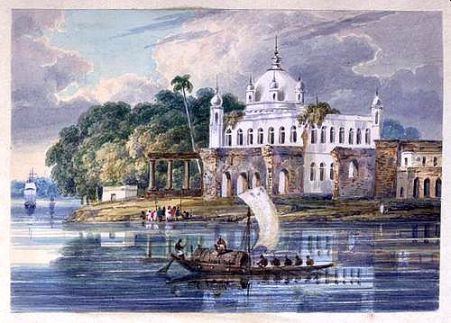
Patna – Source : Royal Asiatic Society
It is highly unlikely that all the seven eminent scholars cited by Rajasekhara arrived at the King’s Court at Pataliputra at the same time. According to Pundit Harprasad Sastri, among these, the earliest to reach the Royal Court of Magadha and to be honoured there were Varsha, Upavarsha and Panini; together with Pingala and Vyadi.
And, Panini distinguished himself in a scholarly assembly at Pataliputra.
Then, there was Vararuchi also called as Katyayana, one of the earliest commentators of Panini. He was some generations away from Panini.
And, the seventh and the last in this group was Patanjali who came about two centuries after Panini; and, he wrote an elaborate commentary on Panini’s work with reference to its earlier commentary by Katyayana.
The last two particularly (Vararuchi and Patanjali) were separated from the first five scholars by a couple of centuries or more.
And, perhaps only the first five among the seven originated from the Takshashila region; while Katyayana and Patanjali came from the East.
Katyayana, according to Katha Sarit Sagara, was born at Kaushambi which was about 30 miles to the west of the confluence of the Ganga and the Yamuna (According to another version, he was from South India). His time is estimated to be around third century BCE.
As regards Patanjali, it is said, that he was the son of Gonika; and, he belonged to the country of Gonarda in the region of Chedi (said to be a country that lay near the Yamuna; identified with the present-day Bundelkhand).His time is estimated to be about 150 BCE. It is said; Patanjali participated in a great Yajna performed at Pataliputra by the King Pushyamitra Sunga (185 BCE – 149 BCE).
[This Patanjali may not be the same as the one who put together in a Sutra- text based on the then available knowledge on the system of Yoga.]
*
By any standards, the seven sages (saptha-munih) formed a most eminent galaxy of extraordinarily brilliant scholars. Each was an absolute Master in his chosen field of study.
The Maha Mahopadyaya asserts that the seven Shastra-kara- names cited by Rajasekhara are mentioned in their chronological order, with Upavarsha being the senior most and the foremost of them all.
*
Further, all the seven learned men were related to each other, in one way or the other.
Of these, the first five were contemporaries coming from Takshashila or near about; and, were closely related.
: – Upavarsha, the eldest, regarded as the most venerable (Abhijarhita); revered as Bhagavan; and, as ‘shastra-sampradaya-pravarttaka’, is described both as Shastrakara and Vrittikara. However, in the later centuries, his name gathered fame as that of a Vrittikara, the commentator par excellence , on the Mimamsa ( a system of investigation, inquiry into or discussion on the proper interpretation of the Vedic texts).
: – Varsha the brother of Upavarsha’s brother, was also renowned as a teacher of great repute.
: – Panini the Grammarian, who gained fame as the author of Astadhyayi , was an inhabitant of Salatura – a suburb of Takshashila , was the student of Varsha.
: – Pingala, the younger brother of Panini, was also a student of Varsha; he was a brilliant mathematician and a master of prosody,
: – Vyadi also called Dakshayana, the fifth in the list, was the maternal uncle (mother’s brother) of Panini. It is said; Vyadi, the Dakshayana, was also a student of Varsha. He was called Dakshayana because: Panini’s mother was Dakshi, the daughter of Daksha. And, Daksha’s son was Dakshaputra or Dakshayana, the descendent of Daksha.
[According to another version, Dakshayana might have been the great-grandson of Panini’s maternal uncle].
*
And, the last two of the seven (Katyayana and Patanjali), coming centuries after Panini were the celebrated commentators on Panini’s Astadhyayi.
The trio (Trimurti) – Panini, Katyayana and Patanjali – are revered as the three sages (Muni-traya) of Sanskrit Vyakarana Shastra. Here, in their reverse order, the later ones enjoy greater authority (yato uttaram muninaam pramaanyam); making Patanjali the best authority on Panini.
Bhartrhari in his Vakyapadia (VP: 2.482), therefore, says: the seeds of all the basic principles are to be found in the Mahabhashya – Sarvesam nyaya-bijanam Mahabhashye nibandane. Bhattoji Diksita also generally gives more importance to the views of Patanjali.

Panini
As per the traditional accounts, Panini was born in Shalātura in North-West India. Panini also mentions: tūdī-śalātura-varmatī-kūcavārāḍ ṭhak-chaṇ–ḍhañ-yakaḥ / PS_4, 3.94/.
A copper plate inscription dated the 7th century CE refers to Pāṇini as Śālāturiya, ‘the man from Śālātura’. This place is identified with a site near modern-day Lahur, a village now in North-west Pakistan, situated on the banks of the River Indus, a few miles away from the ancient university at Takṣaśhilā (called Taxila by the Greeks).
The Chinese Buddhist monk Xuánzàng (Hsüan-tsang), who travelled and studied in India during the 7th century CE, writes that when he reached a place called So-lo-tu-lu , at a distance of twenty Li to the North-west of Udabhanda, in the Gandhara region of the country, he was told that it was the birthplace of the famous sage Pāṇini, who had been ‘from his birth extensively well informed about all things’ .
[Udabhanda is said to be the Prakrit version of the Sanskrit name Udhabhandapura (Udha-banda= water-pot) mentioned in Kalhana’s Raja-tarangini ]
Xuánzàng , another Buddhist traveller who had arrived in this town long-ago , about five hundred years after the death of the Buddha, was then told by a local Brahmin that “The children of this town, who are his [Pāṇini’s] disciples, revere his eminent qualities, and a statue erected to his memory still exists.”.
Sir Alexander Cunningham, the founder of the Archaeological Survey of India, and a renowned expert on Buddhist stupas, identified Salatura as Panini’s birthplace.
*
Panini **, it is said, was the son of Shalanka and Dakshi (meaning the daughter of Daksha). And, Panini was often referred to by his mother’s name as Dākshīputra Pānini (Panini the son of Dakshi) . He had a younger brother Pingala, who later flowered into a brilliant mathematician.
[The Dakshas were said to be a northern clan organized into republican political entities called Janapadas]
[ **However, MM Pundit Shivadutta Sharma held the view that the person whom we call Panini was the son of Salanku; and, the proper name given to the boy by his parents was Ahika. Panini was his Gotra name. In his support, he quotes Kaiyaṭa (11th century) a learned commentator on the Mahābhāṣya of Patanjali. The etymology of the term Panini, according to Kaiyata, is: Panino pathyam, Paninaha, tasyapathyam yuvam Panini (Panini means a descendent of Pani)]
*
All the three: Vyadi, Panini and Pingala studied under Varsha, who perhaps resided in or near Takshashila.
Panani must have been very diligent in his studies ; and, learnt quickly the fundamentals and all the rules of the ever developing language of Sanskrit.
Patañjali, who lived maybe three centuries after Pāṇini, describes him as analpamateh , as one gifted with great intelligence; and quick in grasping :
dhruvaceṣṭitayuktiṣu ca api aguṇe tat analpamateḥ vacanam smarata (P_1,4.51.2)
Patanjali presents a very impressive picture of Pāṇini as teacher, while also paying homage to the Master; commending and acclaiming the authenticity of every single Sutra in the Aṣṭādhyāyī:
There is none equal to my Master (Acharya) Panini (apāṇinīyam tu bhavati. Yathānyāsam eva astu); let alone in the field of Vyakarana; but, in the whole world as well (Na yathā Loke tathā Vyākaraṇe)
The respected preceptor Panini, the Supreme authority in Vyakarana, having taken his seat on a clean place; facing the East (prānmukhah upaviśya); and, holding the purifying bunch of Darbha grass in his hands (pramāna-bhūtah Acāryah darbha pavitra pānih śucau avakāśe), used to formulate Sūtras with great effort (mahata yatnena Sūtrani praṇayati). This being so; it is impossible (asakyam) to find even a single sound or letter (Varna) in any rule (Sutra) that serves no purpose.
(Tatra aśakyam varṇena api anarthakena bhavitum kim punaḥ iyatā sūtreṇa)
A-Pāninīyam tu bhavati. yathānyāsam eva astu . Nanu ca uktam sañjñā-dhikārah sañjñā sampratyaya arthan itarathā hi asampratyayah yathā loke iti. Na yathā loke tathā vyākarane. pramāna-bhūtah ācāryah darbha pavitra pānih śucau avakāśe prānmukhah upaviśya mahatā yatnena sūtram praṇayati tatra aśakyam varṇena api anarthakena bhavitum kim punaḥ iyatā sūtreṇa – (P_1,1.1.3)
*
It is said; while at the Royal Court of Pataliputra, Panini was a much-admired Sutrakara who won many awards at the debating-assemblies. And, he was a favourite of the Shishnaga Kings.
After moving from Takshashila, Panini seemed to have settled down at Pataliputra. He refers often to the Eastern parts of India, the janapada, villages(Grama), cities (Nagara), its dialects (Prakṛtau), its people, social and economic life , images (Pratikṛtau) etc.
( jana-dhana-daridrā-jāgarāṃ pratyayāt pūrvaṃ ).
Panini mentions that the Empire was composed of independent communities Janapadins either ruled by a Kshatriya King or his kinsmen and groups of citizens (Sangha)
Janapadinām janapadavat sarvaṃ janapadena samānaśabdānāṃ bahuvacane || PS_4,3.100 |
In that manner, Panini’s work provides rare glimpses of the life and society of Sixth century BCE India.
**
There are numerous legends associated with Panini.
And, according to one of such legends, Panini’s life ends in a rather bizarre way. It is said, while the great sage was teaching, sitting with his pupils, a lion roared nearby. Instead of running away, Pāṇini started contemplating the tonal qualities of the lion’s roar; and, reproduce its roar.
Then, as the Paṇcatantra tale puts it- Siṃhō vyākaraṇasya karturaharat prāṇan munē: paṇinē – The lion carried away the life of Sage Pāṇini, the author of grammar”.
He was indeed deeply engrossed in the subject of his study unmindful of the surroundings and the dangers it posed. Such was the devotion and dedication of Panini to Vyakarana.
*
There is a belief that the Great Master Maha-Acharya Panini passed away on the Trayodaśī-Tithī (त्रयोदशी तिथी), the thirteenth day. I understand that the traditional scholars , in Eastern India , observe the Trayodaśī-Tithī that occurs in each half (Paksha) of a month as a day of Anadhyayana (अनध्ययन), when studies in Vyakarana are suspended for that day, in honour of the departed Guru.

Panini – his period
Protracted debates were carried out, over a long period of time, to assign a date to Panini.
Western scholars, mainly Max Muller, put Panini in the fourth century BCE; making him almost the contemporary of Katyayana, the author of the Vartikas. And, the Indian scholars, on the other hand, hold the view that Panini cannot be placed later than 2, 800 years before the Vikram era, which starts from 57 BCE. That virtually puts Panini in or around Eighth- Ninth century BCE.
Dr. Goldstiicker, Dr. R. G. Bhandarkar and Prof. K. V. Abhyankar proved that Panini cannot be placed later than 500 B.C. This view is generally accepted by almost all scholars of to-day; and, even late 6th century BCE is also not ruled out with certainty.
*
Yavana (यवनानी)
An important hint for the dating of Pāṇini is the occurrence of the words Yava-Yavana (यवनानी) (in PS: 4.1.49), which term might mean either a Greek woman or a foreigner or Greek script.
Indra-varuṇa-bhava-śarva-rudra-mṛḍa-hima-araṇya-yava-yavana-mātula-ācāryāṇ–āmānuk || PS_4, 1.49 ||
It needs to be mentioned here…
King Cyrus, the founder of Persian Empire and of the Achaemenid dynasty (559-530 B.C.), added to his territories the region of Gandhara, located mainly in the valley of Peshawar. By about 516 BCE, Darius, the son of Hystaspes, annexed the Indus valley; and, formed the twentieth Satrapy of the Persian Empire. The annexed areas included parts of the present-day Punjab.
The Naqsh-e Rustam inscription, on the tomb of Darius I, mentions all the three Indian territories – Sattagydia (Thataguš), Gandara (Gadāra) and India (Hidūš) – as parts of the Achaemenid Empire
Behistun inscription King Darius I (circa 510 BCE) also mentions Gandhara (Gadāra) and the adjacent territory of Sattagydia (Thataguš) as part of the Achaemenid Empire.
*
Many Greek Ionians (Yavanas), Scythians (Sakas) and Bactrians (Bahlikas) served as soldiers of the Achaemenid army; also as officials or mercenaries in the various Achaemenid provinces. And, Indian troops too formed a contingent of the Persian army that invaded Greece in 480 B.C. The Greek historian, Herodotus (c484-425 BCE), describes them : The Indians wore garments made of tree-wool [cotton], and they had bows of reed and arrows of reed with iron points.‖ (Histories 7.65).
Thus the Greeks and Indians were together thrown into the vast Persian machinery for a very long period of time. Thus, Persia, in the ancient times, was the vital link between India and the Greeks of Asia Minor.
The first Greeks to set foot in India were probably servants of the Persian Achaemenid Empire (550-330 B.C.E); and, that vast polity which touched upon Greek city-states at its Western extremity and India on the East. The first Greek who is supposed to have actually visited India; and, to have written an account of it was Skylax of Karyanda in Karia.
Some Greeks, such as the Persian admiral Skylax of Karyanda, were present in Gandhara as co-citizens of the Persian Empire, well before the conquests of Alexander the Great in the 330s BC.
Skylax of Karyanda (late 6th and early 5th century BCE), a sea-captain from Ionia , lived before Herodotus, who tells that Darius Hystargus (512–486) led a naval expedition to prove the feasibility of a sea passage from the mouth of Indus to Persia. Under the command of Skylax, a fleet sailed from Punjab in the Gandhara country to the Ocean.
Scylax is presumed to have started by sailing east along the Kabul River and turned south after its confluence with the Indus River near Attock. Herodotus mentions that once the voyage was completed and proved feasible, Darius conquered the Indians; and, made use of the sea in those parts. Darius seems to have thereafter added to his Empire the lands explored by Scylax as a new province called Hinduš; which the Greek writers termed as India.
*
The historian Sir Aurel Stein writes in his ‘ On Alexander’s track to the Indus‘ writes:
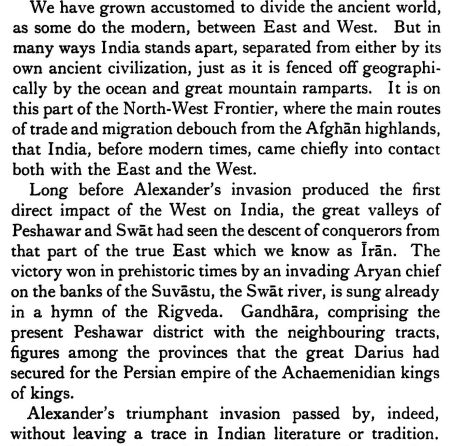
*
Thus, even long before the invasion of Alexander the Great in the 330 BCE, there were cultural contacts between the Indians and the Greeks, through the median of Persia. And, parts of North-West India had already come under the occupation of Achaemenian Empire.
The term Yavana, is, essentially, an Achaemenian (Old-Persian) term. And, it occurs in the Achaemenian Naqsh-e Rustam inscriptions (545 BCE) as Yauna and Ia-ma-nu, referring to the Ionian Greeks of Asia Minor.
[The Hebrew word Yawān (Javan) originally referred to the Ionians, but later was applied to the Greeks as an ethnic or political entity.]
At that date (say 519 BCE, i.e. the time of Darius the Great’s Behistun inscription), the name Yavana probably referred to communities of Greeks settled in the Eastern Achaemenian provinces, which included the Gandhara region in North-West India. All this goes to show that Panini cannot be placed later than 500 BCE.
*
Pāṇini was born in Śālātura to the North-West of Taxila, which was then a Satrapy of the Achaemenid Empire following the Achaemenid conquest of the Indus Valley. Thus, Panini lived in an Achaemenid environment of 6th or 5th Century BCE. And, that technically made Panini a Persian subject.
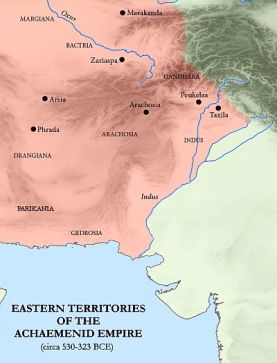
And, therefore, it is very likely that Panini was familiar with the the languages spoken in the area by the officials, traders etc. While Pāṇini’s work is purely grammatical and lexicographic; certain cultural and geographical inferences can be drawn from the vocabulary he uses in his examples, and from his references to fellow grammarians, and new deities such as Vasudeva.
**
The word Yauna was probably adopted by the Indians of the North-Western provinces from the Old Persian; and the administrative languages of the Persian Empire – Elamite or Aramaic. And, its earliest attested use in India, as known to us, was said to be by the Grammarian Pāṇini in the form Yavanānī (यवनानी), which is taken by the commentators to mean Greek script.
During those times and up to the period of Mauryas, Greek was one of the official-languages of the North and North-west India.
Phraotes, the Indo-Parthian King of Taxila received a Greek education at the court of his father ; and spoke Greek fluently. According to the Life of Apollonius Tyana written by Philostratus, the Greek philosopher Apollonius Tyana around 46 CE recounts a talk on this:
“Tell me, O King, how you acquired such a command of the Greek tongue, and whence you derived all your philosophical attainments in this place?”
The king replies, “My father, after a Greek education, brought me to the sages at an age somewhat too early perhaps, for I was only twelve at the time, but they brought me up like their own son; for any that they admit knowing the Greek tongue they are especially fond of, because they consider that in virtue of the similarity of his disposition he already belongs to themselves.”
**
The Buddhist text Milinda Panha (The Questions of King Milinda) dated between second and first century BCE (150 to 110 BCE) is said to be a record of the conversations that took place between the Indo-Greek king Menander I Soter (who is said to have ruled over the regions of Kabul and Punjab); and , the Buddhist monk Bhante Nagasena.
It is believed that debate that took place between the King and the Bhikku was conducted in the Bactrian Greek language; but , it was later rendered into Pali and Sanskrit.
There are several references to the term Yonaka, the Bactrian Greeks in the Milinda Panha. Apart from that, there are other instances. For instance; an inscription in caves at Nasik, near Bombay refers to nine Yonaka who were donors. And the Mahàvamsa also mentions about the Bactrian Greek bhikkhu from Yona; one such monk was named Yona-dhamma-rakkhita.

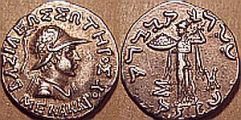
And, Greek was still in official use during the time of Kanishka (120 CE) . As per Prof. Nicholas Sims-Williams (University of London), Kanishka issued an edict in Greek; and then he put it into the Bactrian. The numismatic evidence shows that the coins in Kanishka’s reign carried Greek script.
**
And , of course, the Gandhara Art was very much a reflection or a recreation in the mode of Greek Sculptures. Many of the Greek-art features and deities were incorporated in the representations of the Buddha. The figure of the Buddha was set within Greek architectural designs, such as Corinthian pillars and friezes.
In Gandharan Art, scenes of the life of the Buddha are typically depicted in a Greek environment, with the Buddha wearing heavier toga-like robes. The Buddha images here , are were clearly Greco-Roman in inspiration ; sculpted as in the mode of deities from Greek mythological panthon, displaying wavy locks tucked up into a chignon atop his head .
And, often the Buddha is shown under the protection of the Greek god Herakles, standing with his club resting over his arm. This unusual representation of Herakles is the same as the one on the back of Demetrius’ coins.
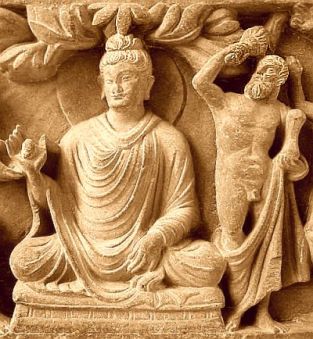
***
Further, Thomas McEvilley ,writes , in his The Shape of Ancient Thought : Comparative Studies in Greek and Indian Philosophies :
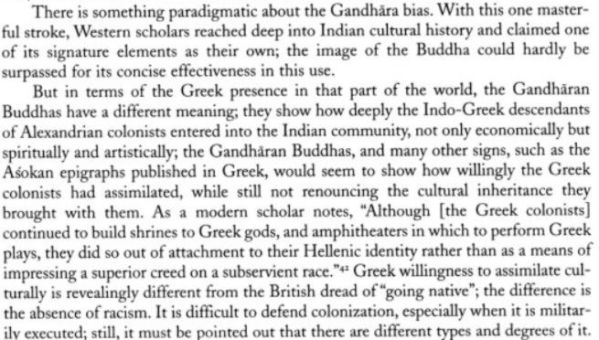
**
Till about the seventh century , Greek was very much a part of the cultural, academic and administrative life of North and North-West regions of India
The Greek script was used not only in manuscripts; but also on coins and stone inscriptions, as late as the period of Islamic invasions in the 7th-8th century CE.
Both the languages-Greek and Sanskrit- seemed to have shared common terms to indicate certain things. For instance :
- Ink (Sanskrit: melā, Greek: μέλαν melan“)
- pen (Sanskrit: kalamo, Greek:κάλαμος “kalamos“)
- book (Sanskrit: pustaka, Greek: πύξινον “puksinon“)
- bridle, a horse’s bit (Sanskrit: khalina, Greek: χαλινός “khalinos“)
- center (Sanskrit: kendram, Greek: κενδρον “kendron“)
- tunnel or underground passage (Sanskrit: surungā, Greek: σύριγγα “suringa”)
- Barbarian, blockhead, stupid” (Sanskrit: barbara, Greek:βάρβαρος “barbaros“)
(Source: https://www.ancient.eu/article/208/cultural-links-between-india–the-greco-roman-worl/ )

Assalayana Sutta of Majjima Nikaya
The fact that Greeks (Yonas or Yavanas) were familiar figures in the North-West-India even as early as in Ca.6th century BCE is supported by a reference in the Assalayana Sutta of Majjima Nikaya.
The Majjhima Nikaya is a Buddhist scripture, the second of the five Nikayas or collections, in the Sutta Pitaka, which is one of the Tipitakas (three baskets) of the Pali Sthavira-vada (Theravada) Buddhism. Composed between 3rd century BCE and 2nd century, this collection is among the oldest records of the historical Buddha’s original teachings.
The Pali Cannon is considered to be the earliest collection of the original teachings of the Buddha; and, it is said to have been composed following the resolution taken at the First Council , which took place at Rajagrha, soon after the Parinirvana of the Buddha. It was transmitted orally for many centuries, before it was reduced to writing in Asoka-vihara, Ceylon during the reign of Vattagamani (first century BCE).
In the Assalayana Sutta (93.5-7 at page 766/1420) , the discussion that took place between an young Brahmana named Assvalayana (Skt. Ashvalayana) and the Buddha , refers to countries of Yona and Kambhoja , beyond the borders (Yona,Kambujesu aññesu ca paccantimesu Janapadesu) which did not follow the four-fold caste division; but, recognized only two classes – viz., slaves and free men. And, in these countries, a master could become a slave; and, likewise, a slave could become a master.
The Buddha says: “What do you think about this, Assalayana? Have you heard in the countries of Yona (Yonarattam; Skt. Yavana-rastram) and Kambhoja (Kambhojarattam; Skt. Kambhoja-rastram) and other districts beyond, there are only two castes: the master (Ayya) and the slave (Dasa)? And, having been a master, one becomes a slave; having been a slave, one becomes the master?” (A-S. 6.2)
Assalayana agrees; and replies: “Yes Master, so have I heard this, in Yona and Kambhoja … having been a slave, one becomes a master.”
Here, Yona is probably the Pali equivalent of Ionia; the reference being to the Bactrian (Skt. Bahlika) Greeks. And, Kambhoja refers to one of the Mahā-janapadas or a district in the Gandhara region of Uttara-patha, to the North of the Madhya-desha (Middle Country).
**
All these go to support the view that Panini’s date cannot possibly be later than 519 BCE.
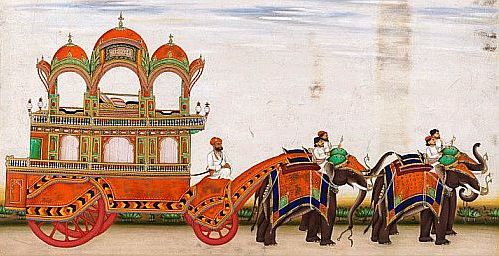
In the Next Part , let’s take a look at
the Chapter-wise structure of Ashtadhyayi,
and some of its definitions and rules
Sources and References
- The Magadhan Literature by MM Pundit Harprasad Sastri
- The Ashtadhyayi of Panini. Translated into English by Srisa Chandra Vasu
Published by Sindhu Charan Bose at The Panini Office, Benares – 1897 - Panini
- Panini –His place in Sanskrit Literature by Theodor Goldstucker, A.Trubner & Co., London – 1861
- Simulating the Paninian System of Sanskrit Grammar by Anand Mishra
- India as Known to Pānini by V. S. Agrawala, Lucknow University of Lucknow, 1953
- Computing Science in Ancient India by Professor T.R.N. Rao and Professor Subhash Kak
- Panini’s Grammar and Computer Science by Saroja Bhate and Subhash Kak
- How Sanskrit Led To The Creation Of Mendeleev’s Periodic Table
- Indian Tradition of Linguistics and Pānini by Prof. Rama Nath Sharma
- Pāṇini: Catching the Ocean in a Cow’s Hoofprint by Vikram Chandra
- Panini: His Work and Its Traditions by George Cardona
- A Brief History of Sanskrit Grammar by James Rang
- Introductionto Prakrit by Alfr ed C . Woolner
- Chandah Sutra of Pingala Acharya, Edited by Pandita Visvanatha Sastri , Printed at the Ganesha Press, Calcutta – 1874
- ALL IMAGES ARE FROM INTERNET
rsrblog
May 27, 2020 at 3:10 am
Respected Sir, Amazing blog post. I could not follow the first two parts, due to my very limited exposure to Sanskrit, vedic or literary. But this third part is familiar to me. Still, I was under the impression that Panini lived and taught in Purushapuram. I have read somewhere that the Vedic verses referred to non-aryan people as pani’s . ( wealthy merchants perhaps of Indus civilization). Is it possible that Panini was not a brahmin but a scholar from the maritime merchant class of Indus valley? I am having in mind, the book by DDKosambi. How is that there is no mention at all about Sir.William Jones, the great linguist? Very happy to learn that you are keeping good health. Best Regards.
sreenivasaraos
May 29, 2020 at 11:48 pm
Dear RSR
Thank you for the visit.
The observation linking the Great Grammarian Panini with the Panis of Rig Veda appears grossly unfounded.
The Panis appear in RV 10.108 as hordes that steal cows. Indra deputes Sarama, the dog, to search for the Panis and negotiate to secure the release of cows. Eventually, the Panis are defeated and the cows are brought home.
Yaska refers to Panis as business minded people, shrewd money lenders or tradesmen. Panis were wealthy people who hoarded money with a very miserly business attitude, lacking in intellectual stability and had very little regard for any Vedic ritual. They are described as nasthika or atheists who decried the Vedas.
पणिः वणिक् भवति ।पणिः पणनात् । वणिक् पण्यं नेनेक्ति । (Nirukta 2.17)
One of the aims of Panini‘s Astadhyayi was to preserve the purity of the Vedas (pradanam cha satsva agreshu Vyakaranam) and, to perpetuate their study over a long period of time (Nitya)
Stay safe, healthy and happy
Regards
Manohar Srinivasan
May 27, 2020 at 5:29 am
Thanks, very good information for reading best regards,
sreenivasaraos
June 2, 2020 at 3:14 pm
Dear Shri Srinivasan
Thank you for the visit; and, for the appreciation
Regards
Rajula
May 31, 2020 at 12:45 pm
Very engrossing series, this, ongoing.
Amazing it is, to see what all goes into the making or unmaking of India. Considering if one is well travelled on paths of understanding the ‘iti-has’ as it has been, as you seem to be, carefully picking up the threads, connecting dots, its a tough tough tough job to actually debate on who we are or how we are separate from this or that race etc.
Slowing down is the one way to touch what is true, isn’t it?
Mii regards
🌿
sreenivasaraos
May 31, 2020 at 5:48 pm
Dear Rajula
Thank you Maa for your observations
Cheers